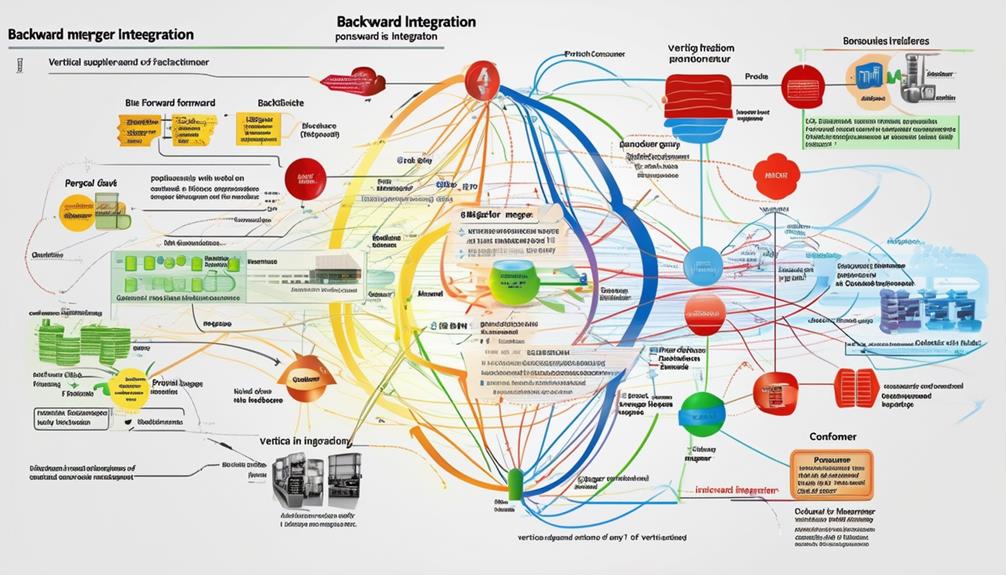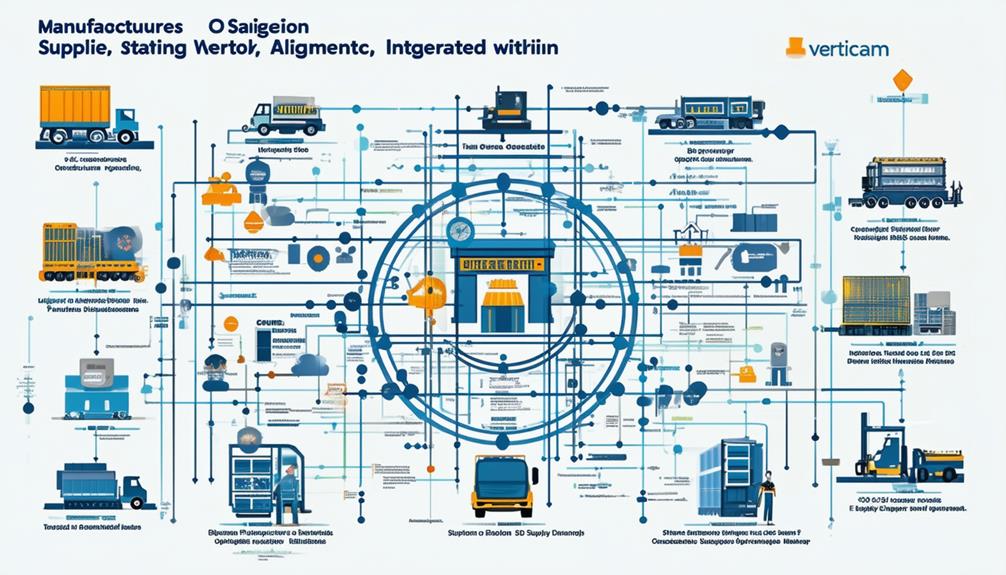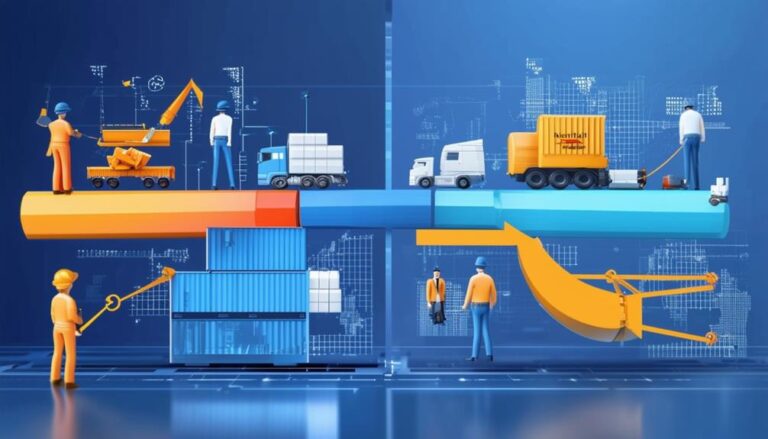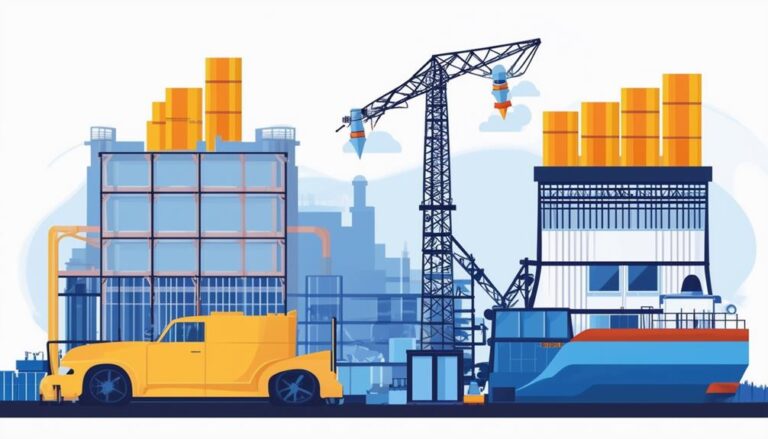Understanding Vertical Mergers

Vertical mergers are when companies at different stages of the supply chain combine forces strategically. These mergers aim to boost efficiency, control over production, and optimize workflow. The goal is to streamline operations, cut costs, and enhance productivity.
By integrating closely, companies can gain a competitive edge, improve supply chain efficiency, and reduce transaction expenses. While vertical mergers bring operational and financial benefits, they also come with challenges like clashes in culture and increased control expenses.
Navigating through these complexities with careful planning and execution is crucial for successful vertical integration. As you delve deeper into this topic, you’ll uncover the intricate dynamics and broader implications of this strategic business maneuver.
Key Takeaways
Vertical mergers bring together companies at different stages of the supply chain, improving efficiency, control over production, and optimizing workflows. The main drivers behind vertical mergers are to streamline operations, increase profitability, and synchronize production stages through careful strategic planning. By joining forces, companies can unlock synergies that lead to improved operational and financial performance.
One aspect of vertical mergers is backward integration, where a company merges with its upstream suppliers to have better control over the supply chain. On the other hand, forward integration involves merging with downstream distributors to expand distribution channels. These integrations help in aligning various stages of production and distribution, ultimately enhancing overall business performance.
While vertical mergers offer significant benefits, they also come with challenges. One common issue is the clash of corporate cultures between the merging entities. Additionally, there may be increased costs associated with maintaining control over the integrated operations. Despite these challenges, vertical mergers remain a popular strategy for companies looking to optimize their production processes and market reach.
In the energy sector, vertical mergers play a crucial role in optimizing production, reshaping industries, and improving the value chain. These mergers enable companies to respond better to market demands, enhance sustainability practices, and have more control over their operations. Overall, vertical mergers in the energy sector contribute to a more efficient and competitive market landscape.
What Is a Vertical Merger?
Vertical mergers involve the combination of two companies that operate at different stages of the same supply chain. This integration allows for improved operational efficiency and control over the production process. By merging with entities in diverse production stages, companies can optimize workflows, reduce costs, and enhance productivity. For example, a manufacturer may merge with a parts supplier to streamline operations and eliminate intermediaries.
The main objective of a vertical merger is to enhance control over the supply chain process. Bringing together companies at various points in the supply chain enables the optimization of workflows, elimination of redundancies, and identification of opportunities for cost reduction. Ultimately, vertical mergers harness increased synergies to drive improved business performance throughout the supply chain. This strategic approach enables companies to adapt and succeed in a dynamic market environment, delivering enhanced value to customers through efficient, innovative operations.
Reasons for Vertical Mergers
Companies pursue vertical mergers to streamline operations, cut costs, and boost profits by aligning different stages of production under one umbrella.
Vertical mergers enable firms to take charge of the entire supply chain, improve efficiency, and maximize productivity.
This integration leads to cost savings and overall enhancement of business performance.
Potential Synergies in Vertical Mergers

Vertical mergers can unlock synergies that optimize operations, boost financial performance, and enhance management practices throughout the integrated supply chain. These synergies drive efficiency, improve productivity, and ultimately strengthen the competitiveness of the merged entity.
Operating synergies in vertical mergers lead to better coordination and workflow between different stages of the supply chain. This improved internal alignment streamlines processes and reduces inefficiencies, allowing for seamless operations and enhanced overall performance.
Financial synergies generated by vertical mergers result in increased liquidity, improved cash flow, and enhanced financial stability. These benefits provide the merged entity with the resources needed to invest in growth opportunities, withstand market fluctuations, and drive long-term value creation.
Managerial synergies in vertical mergers elevate company management practices and decision-making processes. The integrated entity can leverage the expertise and experience of both organizations to enhance strategic planning, optimize resource allocation, and drive innovation across the supply chain.
Challenges in Vertical Merger Success
Vertical mergers, despite their potential synergies, come with challenges that can hinder their success. The clash of different corporate cultures can create friction during the integration process, requiring intentional efforts to bridge the gap. Moreover, the increased costs of control may pose a significant hurdle, necessitating careful management to ensure a seamless transition.
A critical concern in vertical mergers is the risk of losing key personnel, which could have a substantial impact on the newly formed entity’s operations. Overcoming these challenges is pivotal for the successful execution of a vertical merger. Legal aspects, including antitrust laws, must be meticulously addressed to ensure compliance and avoid potential regulatory obstacles.
Acknowledging these hurdles is crucial in navigating the complexities of a vertical merger. By proactively addressing issues such as cultural differences, additional expenses, and legal considerations, organizations can enhance their prospects of reaping the anticipated benefits and synergies. Strategic planning, adaptability, and a steadfast commitment to overcoming obstacles are essential in maneuvering through these challenges successfully.
Backward and Forward Integration

Vertical mergers involve backward and forward integration strategies, allowing companies to secure essential supplies and expand their customer base. Backward integration entails merging with upstream suppliers to control the supply chain and ensure a consistent flow of critical inputs. This reduces reliance on external vendors and safeguards access to necessary materials.
On the other hand, forward integration involves merging with downstream distributors to widen distribution channels and enhance market reach. By integrating both directions of the supply chain, companies can streamline operations and deliver increased value to customers.
The goal of these strategies in vertical mergers is to establish a more efficient and integrated supply chain. By combining upstream and downstream entities, companies gain greater control over the entire value chain. This comprehensive approach enables companies to optimize processes, improve coordination, and enhance overall performance. Through vertical integration, organizations can achieve economies of scale, reduce costs, and strengthen their market position.
Examples of Vertical Mergers
Let’s dive into some examples of vertical mergers in different industries. Time Warner’s merger with Turner Corporation really showed how powerful vertical integration can be in the media world. Google’s acquisition of Android was a smart move that showcased the strategic advantages of a tech giant acquiring a software developer. And eBay’s merger with PayPal demonstrated how vertical integration can lead to increased profitability and smoother operations.
Vertical mergers like these have been instrumental in shaping the business landscape, allowing companies to strengthen their positions in the market and create more value for their customers. It’s fascinating to see how these mergers have influenced the competitive dynamics within their respective industries, paving the way for new opportunities and innovations.
Characteristics of Vertical Mergers
Vertical mergers involve companies joining together at different points along the production supply chain, like Google’s acquisition of Android in 2005. This move aims to streamline operations, broaden distribution networks, increase oversight of manufacturing processes, and harness proprietary knowledge for innovation.
These mergers can improve cost-efficiency and quality management in the supply chain, resulting in better availability and pricing for consumers. By merging with firms at various production stages, businesses can bolster their control over the entire process, reducing risks and uncertainties.
Despite the advantages, vertical mergers present challenges such as potential antitrust issues and a decrease in competition within interconnected markets, which regulators monitor closely. Nevertheless, the benefits of integration, including enhanced efficiency and distribution, make this strategy appealing to companies seeking a competitive advantage.
Key Industries for Vertical Integration
Vertical mergers are common in various industries as a strategic move to strengthen operations, increase competitiveness, and enhance customer service. In healthcare, hospitals have merged with pharmaceutical companies to improve patient care and ensure better access to medications. This trend is mirrored in the automotive sector, where car manufacturers often acquire parts suppliers to streamline production processes and improve quality control.
Tech companies also engage in vertical mergers, with examples including mergers with semiconductor manufacturers to secure a stable supply of components. In agriculture, farmers may merge with food processors to establish a dependable source of raw materials. The energy sector sees vertical mergers between companies and utility providers to optimize production, distribution, and delivery to consumers.
These vertical mergers play a vital role in reshaping industries, promoting efficiency, and enhancing the overall value chain. By integrating different stages of production and distribution, companies can achieve greater control over their operations and better address market demands. The strategic consolidation of resources and capabilities through vertical mergers can lead to a more sustainable and competitive business model.
Successful Vertical Merger Examples

The 1996 merger between Time Warner Inc. and Turner Corporation serves as a classic example of a successful vertical merger. When AT&T acquired Time Warner for $85.4 billion, they aimed to merge content and distribution, positioning themselves to compete more effectively against tech giants. eBay’s integration with PayPal not only increased profits but also streamlined transactions, showcasing the benefits of vertical integration. IKEA’s purchase of forestland ensured a sustainable source of raw materials, illustrating the strategic advantages of vertical integration. Inditex’s acquisition of Indipunt enhanced operational efficiency and sustainability, demonstrating the benefits of vertical mergers in improving business operations.
Vertical mergers offer several advantages, including enhanced market competitiveness through the integration of content and distribution, improved profitability and customer experience through seamless transactions, secured supply of critical raw materials for sustainable business operations, and increased operational efficiency and sustainability through vertical integration.
These successful examples highlight the innovative potential of vertical mergers. Companies strategically integrate to drive growth, streamline processes, and stay ahead of the competition.
Vertical Merger Legality and Controversy
Legal issues can arise from concerns about antitrust violations related to vertical mergers, potentially impacting market competition. Controversies surrounding these mergers stem from the fear that they could lead to reduced competition by allowing firms to control the entire supply chain and block competitors. Critics argue that vertical mergers might encourage collusion among upstream firms, which raises concerns about fair competition. Economists have also expressed worries about how these mergers could distort market dynamics and limit access to essential raw materials.
Antitrust concerns with vertical mergers include the risk of decreased market competition, the potential for collusion among upstream firms, and the need to comply with antitrust laws. These mergers could also result in blocking competitor access, manipulating the supply chain, and creating barriers to new market entrants. Regulators play a crucial role in overseeing the merger approval process to ensure fair market access and healthy competition.
To navigate the legal and controversial aspects of vertical mergers, companies must carefully consider antitrust compliance, fair competition principles, and the overall impact on market dynamics. It’s essential for innovative companies to remain vigilant and ensure that their vertical integration strategies align with regulations to maintain a competitive and healthy market environment.
How Vertical Mergers Work

Let’s dive into the world of vertical mergers, where companies come together to create a seamless connection between suppliers and customers. These mergers focus on integrating different stages of the production process to improve efficiency and streamline operations. By combining forces, these firms aim to gain better control over their supply chains, leading to significant synergies and operational benefits.
Vertical mergers bring together companies that operate at different points in the production and distribution process. This integration allows for a smoother flow of goods and services, from raw materials to the end consumer. By consolidating these relationships, companies can optimize their operations and reduce costs.
Through vertical mergers, firms can achieve a competitive edge by enhancing their ability to coordinate production, distribution, and sales. This alignment of resources and capabilities enables companies to respond more effectively to market demands and changes in consumer preferences. By uniting their strengths, vertically integrated firms can adapt faster to market dynamics and drive innovation in their respective industries.
Supplier-Customer Relationships
In a vertical merger, the supplier and customer collaborate closely to align their processes, optimize resources, and maximize overall performance. By integrating across supply chain stages, efficiency is enhanced, synergies are created, and quality control is improved.
Streamlined operations and improved information flow result in cost reductions along the supply chain. Strong supplier-customer relationships, founded on trust and cooperation, enhance competitiveness in the market. Aligning production schedules and inventory management optimizes resource utilization, reducing waste and redundancies.
Integration of systems and data sharing enables real-time visibility, facilitating proactive decision-making and responsive supply chain management. Successful vertical mergers lead to a fully integrated supply chain, strategically aligned to drive innovation, enhance quality, and improve market positioning.
This high level of collaboration and synergy is essential for outperforming competitors and delivering exceptional value to customers.
Integrated Supply Chains
Integrating supply chain stages through vertical mergers optimizes operations, boosts efficiency, and enhances overall competitiveness. By combining production, distribution, and sourcing functions, synergies are created that optimize costs, quality, and information flow throughout the supply chain. This enhanced control over the supply chain allows for refining processes, improving productivity, and reducing expenses, all of which contribute to stronger business performance.
Vertical mergers are a strategic move that enables capitalizing on the complementary nature of operations. Leveraging the expertise and resources of partners drives operational efficiency, eliminates redundancies, and better serves customers. This collaborative approach fosters a more integrated and responsive supply chain, positioning to adapt quickly to changing market demands.
Ultimately, integrating supply chain stages through vertical mergers empowers streamlining processes, enhancing competitiveness, and delivering greater value to stakeholders. Aligning capabilities and optimizing the supply chain positions us to tap into new growth opportunities and solidify our position in the industry.
Benefits of Vertical Mergers
Vertical mergers offer companies the opportunity to streamline operations, reduce costs, and enhance overall efficiency. By integrating different stages of the supply chain, businesses can achieve better management of resources and improved coordination. This can result in increased profitability and a stronger competitive position in the market.
Successful vertical mergers have shown the benefits of enhanced quality control and a more competitive edge through tighter integration of critical business functions. Companies that engage in vertical mergers often gain access to valuable resources, intellectual property, and patents that can further boost their market presence and innovation capabilities.
One of the key advantages of vertical mergers is the potential for synergies in financial, managerial, and operational aspects. This can lead to improved productivity, cost savings, and overall business growth. By aligning goals and strategies across different levels of the supply chain, companies can create a more cohesive and efficient operation.
Frequently Asked Questions
What Is a Vertical Merger in Simple Terms?
A vertical merger is when two companies join together that are at different points in the supply chain. This can lead to increased efficiencies, better control over the production process, and the ability to create new and innovative business models. This type of merger can help companies streamline their operations and improve their overall performance.
What Is a Real Life Example of a Vertical Merger?
Let’s take a look at a real-life example of a vertical merger. One notable case is the merger between Disney and Pixar in 2006. Disney, a well-established entertainment company, acquired Pixar, a leading animation studio known for its innovative storytelling and groundbreaking technology.
This merger allowed Disney to strengthen its position in the animation industry by gaining access to Pixar’s talented team and successful film franchises like Toy Story and Finding Nemo. By vertically integrating with Pixar, Disney was able to expand its creative capabilities and reach a wider audience with high-quality animated content.
The Disney-Pixar merger is a classic example of how vertical mergers can create synergies and drive innovation in the entertainment sector. It showcased how two companies with complementary strengths can come together to enhance their competitive advantage and deliver value to customers.
What’s the Most Common Reason for a Vertical Merger?
One common reason for a vertical merger is to reduce costs by combining different parts of the supply chain. This can help companies save money and become more efficient in their operations. By integrating functions like production, distribution, and retail, organizations can streamline processes and cut down on expenses. This, in turn, can lead to higher profits and better overall performance for the business.
What Are the Drawbacks of Vertical Merger?
We are aware that vertical mergers have drawbacks such as reducing competition, integrating operations can be challenging, risks of engaging in monopolistic practices, and smaller companies may struggle to compete with larger merged entities due to their increased market dominance.
Conclusion
Vertical mergers occur when two companies operating at different stages of the supply chain, such as a manufacturer and a distributor, join forces. This type of merger can lead to increased efficiency and cost savings by streamlining operations and eliminating middlemen.
One of the main reasons companies engage in vertical mergers is to gain more control over their supply chain. By integrating different stages of production, companies can ensure a smoother flow of goods and better coordination between different parts of the business.
Vertical mergers can also lead to improved innovation and product development. By bringing together different expertise and resources from each stage of the supply chain, companies can create new and improved products that meet customer needs more effectively.
Overall, vertical mergers can be beneficial for companies looking to strengthen their position in the market and achieve greater operational efficiency. By strategically combining different parts of the supply chain, companies can create a more integrated and competitive business model.





